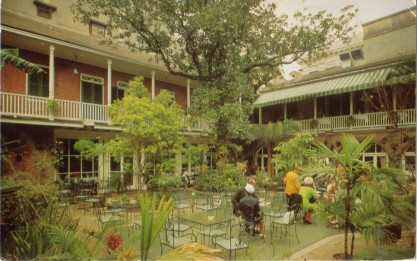
When contacting us by e-mail, correspondents are asked to include their name and full postal address and, when providing information, to quote exact book and magazine sources. The word ‘chess’ needs to appear in the subject-line or in the message itself.
| First column | << previous | Archives [13] | next >> | Current column |

The reverse of the card reads:
‘Patio, Brennan’s French Restaurant, 417 Royal Street, New Orleans. This handsome structure and patio, one of the Vieux Carré’s most interesting, was erected during the twilight of Spanish rule over Louisiana by Don José Faurie, a wealthy merchant. Later it housed The Louisiana Bank, first banking institution in the Louisiana Territory. Later still, it was the home of Paul Morphy, world-famous chess champion.’
An official website has been launched for the ‘FIDE world championship 2005’ in San Luis, and Christian Sánchez (Rosario, Argentina) draws our attention to its list of world title matches History of the World-Wide Championships. The blunders, misspellings, omissions, etc. are so gross that most readers, we imagine, will easily spot 20 or so. A more difficult task is to understand how a chess organizer could even consider treating the game’s history so disdainfully.
From Rick Kennedy (Columbus, OH, USA):
‘On pages 68-69 of A Chess Omnibus the article “Wing gambits” presented the game W.M. de Visser v W.P. Shipley, Manhattan v Franklin Team Match, 30 May 1900 with annotations by de Visser from the September 1900 BCM (taken from the Brooklyn Daily Eagle), which called 1 e4 c5 2 b4 the “Garrat Wing Gambit”. You asked what the grounds were for this name, and I now have a possible answer.
The Chess Digest booklet Sicilian Wing Gambit: A Historical Survey by James J. Romeo (circa 1982) discusses the de Visser v Shipley game with the following historical note on pages 5-6:
“In this game, de Visser plays the Full-Wing. As far back as Greco, the move P-QR3 is thematic in the Wing Gambit, but it was not played immediately on the third move until the end of the 1800s. In his notes to the game, de Visser makes the comment that this opening is known as the Garrat Wing Gambit, and played quite often by H.E. Bird. Although de Visser mistakes the old German script S (for Sarratt) for a G (which it looks like), at least by the turn of the century it was recognized that Bird was merely an advocate of the opening, and not its discoverer.”
Earlier in this History chapter (page 4), Romeo wrote:
“1813 – J.H. Sarratt. In this book, Sarratt translates chess treatises by Damiano, Ruy López, and Salvio, and augments this material with his own analysis. As an appendix to this work, Sarratt includes four games from the 1623 Greco Manuscript ...”
Romeo’s explanation appears to be his own assessment, as he gives no source, but it is plausible.’
Calle Erlandsson (Lund, Sweden) mentions the following extensive list of films with chess scenes: Chess in the cinema/Schach im Kino.
We take this opportunity to quote from page 11 of the October 1919 Chess Amateur an item entitled ‘Chess and the Cinema’ in the inimitable prose of P.H. Williams (1873-1922):
‘The Cinema should reflect the spirit of the times. There is a poster in London, illustrating a drama called The Summer Girls, where a lady and gentleman are playing chess. The latter’s face, and the terrible furrows on his forehead, might suggest that he had a bad defence. But as there is clearly a lively bonfire or explosion, in lurid red, immediately beneath his chair, his agitation is comprehensible.
Thus are the characteristics of the noble game set forth in Cinema-land, to show its calm and intellectual joys. But I may say that the Vesuvian manifestation is really well placed; for the gentleman, who appears to be playing the part of a mutton-chop with delirium tremens, is clearly a villain. Any student of the six-act thrill in ten reels can see that, by the glint in his eye and the “Ha-ha! Do not r-r-rrroue muh, gy-url!” (which is probably projected in letter-press later on); these are infallible omens of criminality. Thus the conflagration is in accordance with decorum and morality. His ultimate cremation is inevitable. This sort of peaceful drama is a welcome relief from the never-ending views of sleuth-hounds, diamond tiaras, telephones, revolvers, prancing cow-boys, lassos, detectives, collisions, marriage in balloons, poison-draughts, old ladies reading the Bible, cannibals and so forth.’
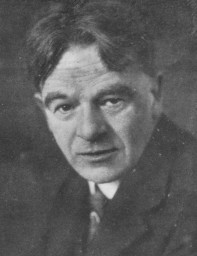
Philip Hamilton Williams
Tim Harding (Dublin) sends the following item by T.B. Rowland from the Dublin Evening Mail of 29 October 1896:
‘An Infant Prodigy. An infant chess prodigy has been discovered in the person of Master Aron Niemzowitch, the nine-year-old son of a merchant of Riga, in Southern Russia [sic]. The following short game, played recently, is a specimen of his play: 1 e4 d5 2 exd5 Qxd5 3 Nc3 Qd8 4 Nf3 f5 (This is of course a weak move ...) 5 Bc4 Nc6 6 O-O Qd6 7 d3 Qb4 8 Be3 Qxb2 9 Nd5 Kd8 10 Bc5 b6 11 Rb1 Qxb1 12 Qxb1 bxc5 13 Ng5 Ne5 14 f4 h6 15 fxe5 hxg5 16 Ne3 f4 17 e6 fxe3 18 Rxf8 mate. (Black’s play is weak throughout, but the remarkable part of this little game is the able manner in which the boy takes full advantage of the weaknesses of his adversary. The St Petersburg Zeitung, in commenting on the above game, remarks, “We need no longer look to America for our chess prodigies”.)’
Mr Harding adds:
‘How many intermediaries there may have been between Rowland and the Petersburg paper I cannot say.’
One early publication of the score was in the Deutsches Wochenschach, 4 October 1896 (page 373). As far as we know, it is the only extant game by Aron Nimzowitsch from the nineteenth century.
From Neil Brennen (Spring City, PA, USA) comes this game, won by a 12-year-old:
N.N. – Victor Abraham
Cincinnati, circa 1860
Bishop’s Opening
1 e4 e5 2 Bc4 Bc5 3 Qe2 Nf6 4 Nc3 O-O 5 Nf3 c6 6 Nxe5 d5 7 exd5 cxd5 8 Bb3 Re8 9 f4 Bg4 10 Qd3 Nc6 11 Nxd5 Nxe5 12 Qg3 Nd3+ 13 Kf1 Be2 mate.
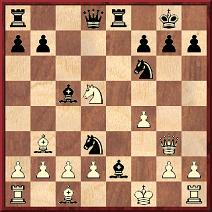
Source: Lynn News, 11 January 1860.
John Donaldson (Berkeley, CA, USA), who is preparing a new edition of his two volumes on Rubinstein (co-written with Nikolay Minev in the 1990s), asks for information about a little-known opponent of Rubinstein’s.
‘The following is from page 271 of our first volume, Uncrowned King:
“Another budding talent in the field was Jozsef Dominik. Like Belsitzmann he started his tournament career just before the First World War and perished not long after the armistice. Equally unknown and another fine player was L. Szwarcman. So little is known about Szwarcman – who isn’t listed in Gaige or Litmanowicz and Giżycki’s two volume encyclopedia – that his first name, birth and death are a mystery. We note that he didn’t participate in the Polish Chess Championships of 1925 and 1926 and theorize that he was yet another victim of the First World War and its aftermath.”
Now, though, a correspondent, Alan Smith, has raised the interesting question of whether L. Szwarcman may have made his way to France in the 1920s and emerged as L. Schwartzmann, who played in Hyères, 1927 and Paris, 1929. His results suggest that he was definitely a master; at Paris, 1929, for example, he scored wins over Menchik, Duchamp and Koltanowski. Unfortunately we have been able to find no biographical information on him.’
This will be a tricky matter to resolve, and readers’ assistance will be appreciated. As regards French-language chess literature, an early reference is ‘L.-L. Schwartzmann’ on page 253 of the November 1926 issue of La Stratégie (a news item on the Paris Championship, which he went on to win). Magazines were inconsistent in spelling the surname. For instance, pages 290-292 of L’Echiquier, July 1929 had ‘Schwarzman’, ‘L. Scharzmann’ and ‘L. Schwartzmann’, whereas page 281 of the same issue twice put ‘Schwarzmann’.
A group photograph taken at Hyères, 1927 was given in C.N. 3606, from the March 1927 issue of L’Echiquier. The player standing second from the left was identified by the Belgian magazine as ‘L. Szwarzman’. See the first illustration below for a detail. The other photograph here (taken at the Paris, 1929 tournament) comes from L’Echiquier, August 1929 and shows ‘Schwarzmann’ (during his game against Baratz).
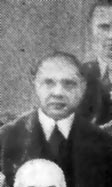
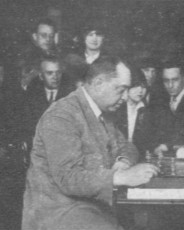
‘Szwarzman’ (1927) and
‘Schwarzmann’ (1929)
It will be noted that the 1927 spelling ‘Szwarzman’ is almost identical to ‘Szwarcman’, i.e. Rubinstein’s opponent at Warsaw, 1919, as referred to by Mr Donaldson. Moreover, page 3 of the Chess Player booklet on Paris, 1929 (published in Nottingham in 1999) has a reference to ‘L. Schwartzmann (Poland)’.
We can go no further for now, apart from throwing an additional complication into the pot: page 38 of La Stratégie, February 1926 carried a report on a France v England correspondence match in which a game was won by ‘Mlle Schwartzmann’.
Michael McDowell (Westcliff-on-sea, England) sends the following problem by H.E. Bird, from Loyd’s column in the Scientific American Supplement, 20 October 1877 (page 1502):
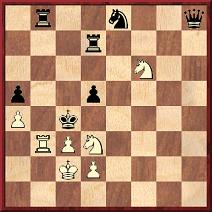
Mate in four.
Regarding Bird, Loyd wrote in the same column:
‘... [we] cannot close without adding our tribute to his skill as a composer of chess problems of great beauty and merit ... and are particularly pleased to find a player like Mr Bird, who has encountered the champions from almost every clime, gives it as his candid opinion that he has never known a good problemist who was not a fine chessplayer.’
Below is the sketch by Loyd which accompanied the tribute:
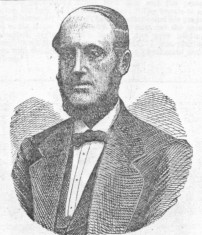
Henry Edward Bird
From Alexei Shirov (Riga):
‘Towards the end of the 1990s, or possibly in 1995-96, the Russian magazine Shahmatny Vestnik published an article on Tartakower’s poetry in Russian, giving the text of some poems (which were rather average in my view, but by no means bad) and also citing Nikolai Gumilev (a well-known Russian poet), who expressed a rather high opinion of Tartakower’s literary abilities.’
Can a reader trace the article in question and kindly send us a copy?
C.N. 3851 referred to Zukertort’s famous brilliancy against Blackburne at London, 1883, and now we note that on page 45 of the August 2005 Chess Life a reader of the ‘Evans on Chess’ column asserts:
‘Everyone, and I do mean everyone, gives 31 Bxe5+ an exclam, yet about 30 years ago I found a significant improvement’ [i.e. a forced mate in seven beginning with 31 Rg8+].
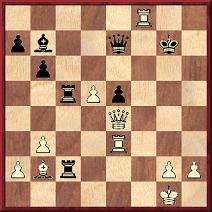
C.N. 2193 (see page 97 of the 5/1998 New in Chess and page 5 of A Chess Omnibus) pointed out that the forced mate with 31 Rg8+ was given by Edgard Tchélébi on page 60 of the March 1957 BCM.
We look forward to Tchélébi being accorded proper credit. And on the subject of necessary corrections in Chess Life, C.N. 3482 drew attention to an untrue statement about Golombek written by Raymond Keene and unquestioningly quoted by Larry Evans on page 42 of his December 2004 column.
In C.N. 3849 Gordon W. Gribble (Hanover, NH, USA) offered two photographs of the house in New Orleans where Morphy died. He also photographed the residence, a few blocks to the east, where Morphy was born:
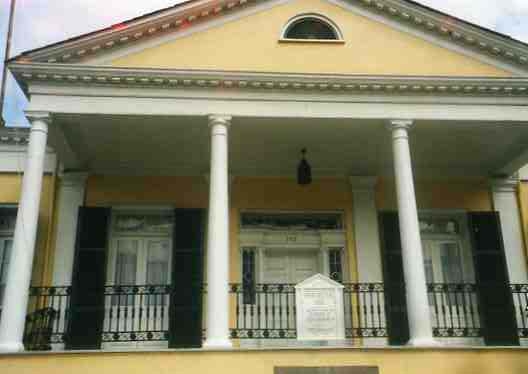
This is the Beauregard-Keyes House, 1113 Chartres Street. The second photograph appeared on page 10 of Regina Morphy-Voitier’s 1926 booklet Life of Paul Morphy in the Vieux Carré of New-Orleans and Abroad:
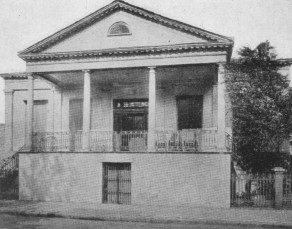
Which world champion made the statement below?
‘As has been known for a long time, I am a very solitary person and have very few relations with the outside world.’
The following exchange of correspondence between Bobby Fischer and the Encyclopaedia Judaica was received by us in 1988 from Fischer’s address in Pasadena:
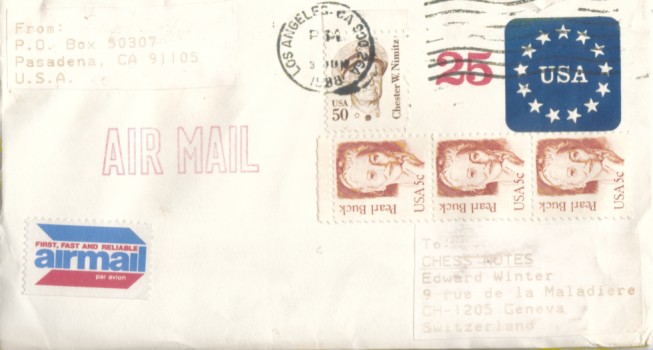
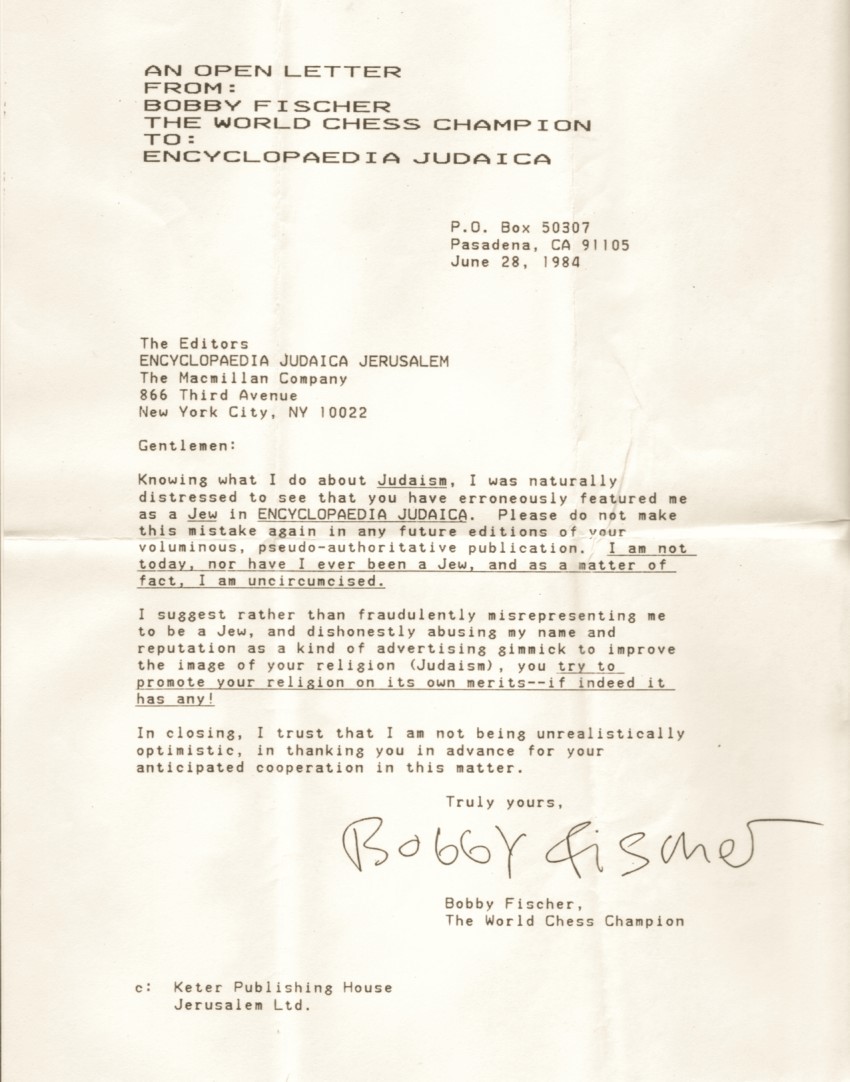
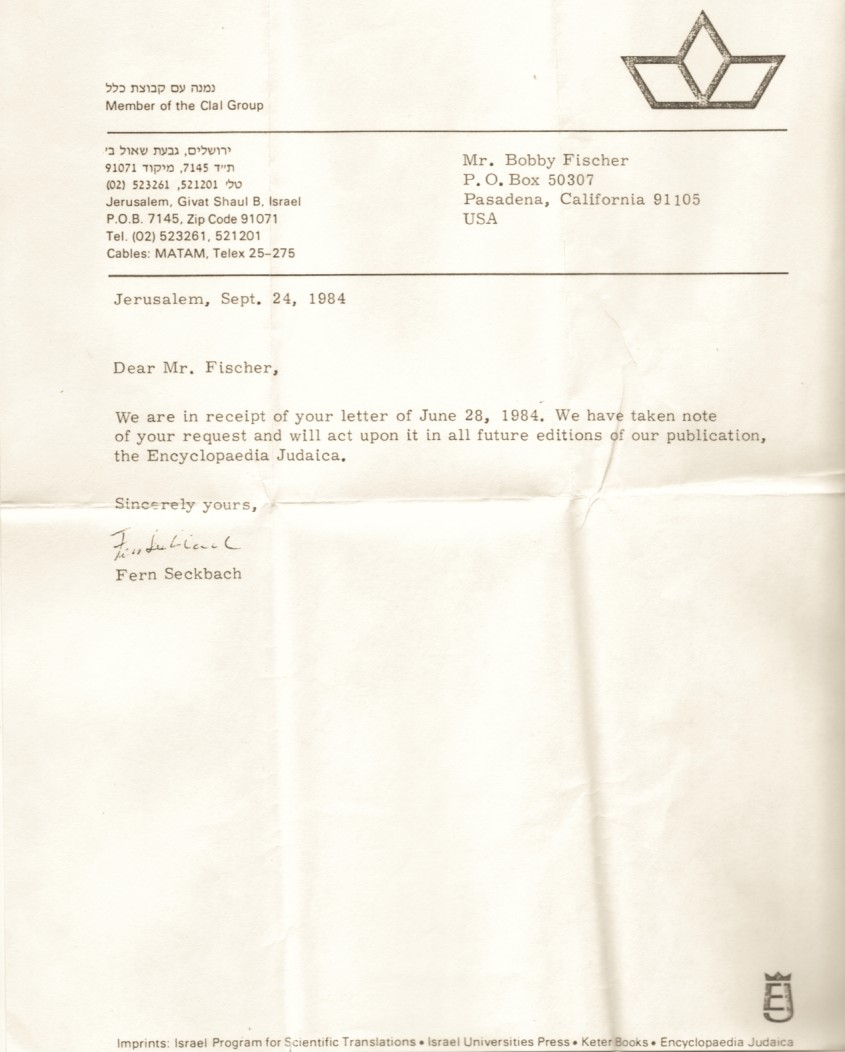
Some years ago (see pages 230-232 of Kings, Commoners and Knaves) we discussed chess connections involving Viveca Lindfors and Errol Flynn, who co-starred in the 1948 film Adventures of Don Juan. In passing we described Viveca Lindfors as ‘the only screen goddess lucky enough to marry a FIDE President’ (i.e. Folke Rogard). This 1946 photograph of the couple appeared in her autobiography Viveka ... Viveca (New York, 1981):
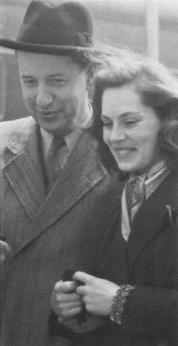
She was later married to the actor and writer George Tabori, and her book also has the following shot, ‘the first picture of the Tabori-Lindfors family in the house on 95th Street’:
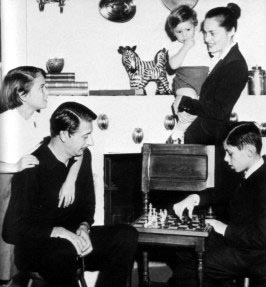
‘Errol Flynn is another film-star chess-ite’, wrote CHESS, 14 November 1937, page 79, and the photograph below shows him playing against Olivia de Havilland during the shooting of They Died with Their Boots On (1942):
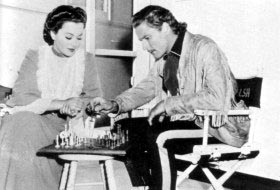
From our collection comes this photograph of Errol Flynn, inscribed by him in 1940:

And, as a tailpiece, an extract from page 8 of the new Gambit Publications book Secrets of Attacking Chess by Mihail Marin (London, 2005):
‘I am sure most of us have been captivated by the cape and sword movies of the 1960s, featuring such fine actors as Errol Flynn.’
Not exactly. Flynn died in 1959.
From Calle Erlandsson (Lund, Sweden):
‘Leon Szwarcman (1887-1942) has a chapter (pages 121-123) in Tadeusz Wolsza’s Arcymistrzowie, mistrzowie, amatorzy, volume 3 (Warsaw, 1999). Four of his games are given, as well as a list of tournament results from St Petersburg, 1911 to the 1936 Paris championship.
Apparently he was born in Warsaw in 1887, studied in St Petersburg, and at the end of his life was arrested and transported to Auschwitz, where he died on 3 September 1942.’
Below are two games given by Wolsza (on pages 122-123):
Leon Szwarcman (Leon Schwartzmann) – Mojzesz Hirszbajn
Warsaw, 1922
Ruy López
1 e4 e5 2 Nf3 Nc6 3 Bb5 a6 4 Ba4 Nf6 5 Qe2 Be7 6 c3 b5 7 Bc2 d6 8 d3 O-O 9 Nbd2 Bg4 10 h3 Bh5 11 g4 Bg6 12 Nf1 Re8 13 Ng3 d5 14 h4 h5 15 g5 Ng4 16 Nh2 dxe4 17 dxe4 Qd7 18 Nxg4 Qxg4 19 Qxg4 hxg4 20 h5 Bh7
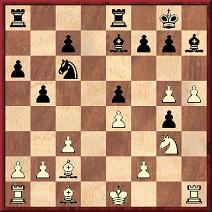
21 g6 Resigns.
Leon Schwartzmann (Leon Szwarcman) – W. Dembo
Paris, 1927
Alekhine’s Defence
1 e4 Nf6 2 e5 Nd5 3 Nc3 Nxc3 4 bxc3 d6 5 Bc4 d5 6 Be2 c5 7 f4 g6 8 Nf3 Nc6 9 O-O Bg7 10 d4 c4 11 Nh4 e6 12 Qe1 Bd7 13 Rb1 b6 14 Qg3 Rg8 15 Bf3 f5 16 exf6 Bxf6
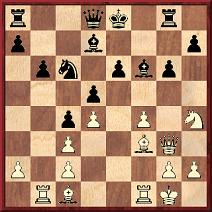
17 Nf5 exf5 18 Bxd5 Rg7 19 Ba3 Be7 20 Rbe1 Kf8 21 Rxe7 Rxe7 22 Qh4 Kg7 23 Bxe7 Qxe7 24 Qxe7+ Nxe7 25 Bxa8 Resigns.
Brad Dassat (Oldham, England) mentions that a game between Alekhine and a player named Schwartzmann (circa 1916) was given on pages 60-62 of the March 1956 BCM. Page 122 of the Skinner/Verhoeven book on Alekhine suggested, however, that the opponent was P. Schwartzmann (and that the game was played in Petrograd in December 1916).
It is not only the old-timers’ quotes which may prove difficult to trace. Page 56 of Modern Chess Analysis by R. Smith (London, 2004) attributes to Seirawan the observation ‘Let the perfectionist play postal’. It is, indeed, a commonly-seen quote, but Yasser Seirawan (Seattle, WA, USA) informs us:
‘At the moment I simply cannot place this remark.’

A further discovery has been made regarding Fischer v Bolbochán, Stockholm, 1962, but first a synopsis of the story so far. As noted in our article Fischer’s Fury the 1995 Batsford edition of My 60 Memorable Games incorrectly altered Fischer’s analysis:

Fischer wrote that 40 Qxf1 leads to a win, but Batsford changed this to ‘40 Qh7+ Kf8 41 Qh8+ Qg8 42 Qh6+ Qg7 43 Qxg7 mate’. However, 42 Qh6+ is illegal, because 41…Qg8 gave check.
In C.N. 2762 Steve Giddins (Moscow) wrote:
‘... it has now come to my attention that the same error is made in the Russian book 744 partii Bobbi Fischera. Like many Russian books, this one reproduces annotations from other sources (presumably without paying royalties), including those from My 60 Memorable Games. The relevant note to Fischer-Bolbochán (volume 1, page 283) ends “39 Qh3+ s matom” (i.e. “with mate”), rather than “39 Qh3+ Kg8 40 Qxf1 leads to a win”, as Fischer originally wrote.
It thus appears that the Russian authors have not only fallen into the same tactical trap as Graham Burgess did in the Batsford book but that they have also, like him, changed Fischer’s own analysis, rather than merely adding a footnote pointing out the alleged “error”.
The Russian book came out in 1993, two years before the revised Batsford edition, so the latter was clearly not the source for the translation.’
In C.N. 2768 we commented:
‘The relevant part of the Fischer-Bolbochán game in the Russian translation of Fischer’s own work, Moi 60 pamyatnykh partii, was identical to what appeared in the book 744 partii Bobbi Fischera.
As regards the volume by Fischer, therefore, the Russian translation (1972) and the Batsford book (1995) both made the same silent ‘correction’ of his analysis, i.e. they both introduced, in Fischer’s name, a mating line which was nothing of the kind. A plain question arises: was this coincidental?’
Now, Zalmen Kornin (Curitiba, Brazil) points out to us that the same illegal line of play appeared in Schachmeisterpartien 1960-1965 by Rudolf Teschner, a book which was first published in 1966.

The imprint page of our copy has ‘© Philipp Reclam jun. Stuttgart 1966’ and ‘Printed in Germany 1972’, and below is the relevant extract, from pages 103-104:
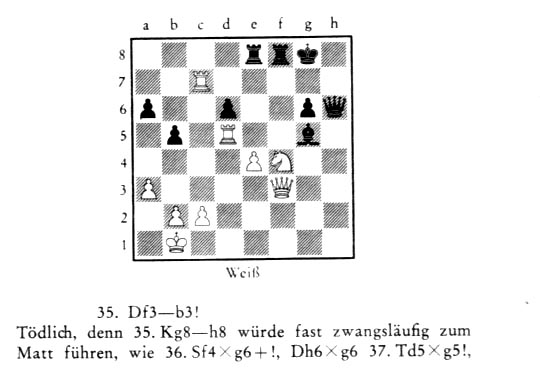
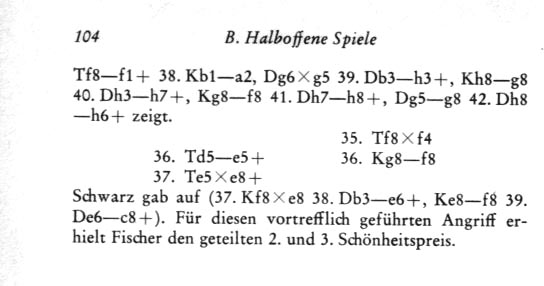
English translation of the note at move 35: ‘Deadly, since 35...Kh8 would almost inevitably lead to mate, as is shown by 36 Nxg6! Qxg6 37 Rxg5! Rf1+ 38 Ka2 Qxg5 39 Qh3+ Kg8 40 Qh7+ Kf8 41 Qh8+ Qg8 42 Qh6+.’
This is the identical mate-that-isn’t line which Batsford misattributed to Fischer in 1995. It will be appreciated if a reader who has the first (1966) issue of Teschner’s book could confirm that its text is identical to what has been reproduced above from the 1972 printing. If such is the case, it will have been found that this spurious mate had appeared in chess literature even before the publication (in 1969) of the first edition of My 60 Memorable Games. [It was subsequently possible to establish that the 1966 edition of Teschner’s book did indeed have the identical text.]
From page 24 of How to Play Chess Like a Champion by Fred Reinfeld (New York, 1956):
‘At the chessboard Zukertort was a remarkable mixture of deep analytical powers and far-reaching intuitive genius. He produced beautiful moves with the practiced ease of a conjurer.
The following combination [against Blackburne at London, 1883], generally recognized as his finest, has always had a special fascination for me. When I was 11 years old, I learned the moves by reading the article on chess in the Encyclopaedia Britannica. Included in the article were a number of memorable master games, and one of them contained the following combination.
The sequence of incomprehensible moves troubled me. For three months I played over the combination every day, hoping to puzzle out its why and wherefore. But I failed to fathom it – and no wonder. For this combination is one of the sublime examples of the art of chess.’
That quote is a welcome addition to our series entitled ‘When did Reinfeld learn chess?’ (C.N.s 2116 and 3285), which has presented the following incompatible statements:
‘Born in New York on 27 January 1910, Fred Reinfeld learned the moves of the game at the age of nine and, as he himself confesses, forgot in five minutes all he had learned in ten. He challenges anybody to duplicate that record. Subsequently, he became interested for a time in checkers, but abandoned the sister game in favour of chess.
Around Christmas of 1923 Reinfeld began haunting the libraries in search of chess literature, much of which he was at great pains to copy. At length he had a collection of some 2,000 games. At that time he was studying at De Witt Clinton High School and in due course earned a place on the school team.’
C.N. 3426 referred to the blind player Oscar Bilgram (1878-1958), and now Neil Brennen (Fair City, PA, USA) provides this passage by Gustavus Reichhelm from his Philadelphia Times column of 19 March 1892:
‘The following neat 8x4 problem was made by Master Oscar Bilgram, a blind boy, of this city, 14 years of age. He has long favored us with weekly solutions and he shows a remarkable aptitude for the noble game.’
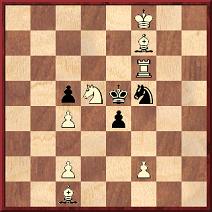
Mate in two
C.N. 3817 mentioned that we had never seen the moves of Elaine Saunders’ game against Alekhine. Maurice Carter (Fairborn, OH, USA) informs us that in a letter to him dated 19 February 1993 David Pritchard (later Elaine Saunders’ husband) was able to provide part of the game-score:
Alexander Alexandrovich Alekhine – Elaine Saunders
London, 22 January 1938
Sicilian Defence
1 e4 c5 2 Nf3 Nc6 3 d4 cxd4 4 Nxd4 d6 5 c4 Nf6 6 Nc3 g6

7 c5 dxc5 8 Nxc6 Qxd1+ 9 Nxd1 bxc6 10 f3 Bg7 11 Be3 Nd7 12 Rc1 Rb8 13 b3 O-O 14 Nf2 Bb7 15 Nd3 Bd4 16 Kf2 f5 17 exf5 Rxf5 18 Be2 Rbf8 19 Rhd1 Rd5 20 b4 cxb4 21 Nxb4 Bxe3+ 22 Kxe3 Re5+ 23 Kf2 Nc5 24 Nd3 Nxd3+ 25 Bxd3 Ra5 26 Bc4+ Kh8 27 Rd7 Bc8 28 Rxe7 Rc5 (David Pritchard: ‘Elaine’s score then became corrupt. The end position (in which Elaine resigned – this was published) was ...
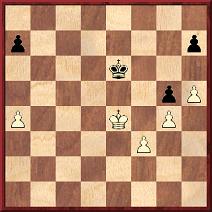
... after move 73 with (presumably) Elaine to move – she doesn’t remember.’)
Our correspondent Maurice Carter asks whether it is possible to identify the masters in action in the photograph from the Dresden, 1926 tournament given between pages 240 and 241 of Complete Games of Alekhine, volume three by V. Fiala and J. Kalendovský (Olomouc, 1998). Rubinstein and Tartakower are identifiable, he remarks, but who are the others?
A larger version of the picture appeared at the beginning of the Dresden, 1926 tournament book:
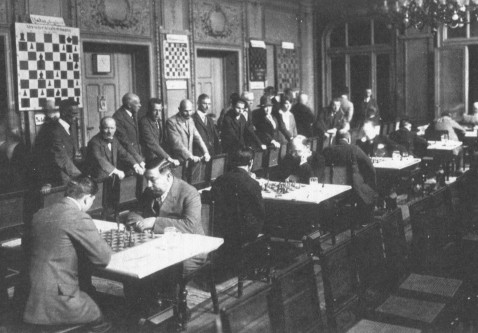
On the basis of the pairings we believe that it was taken during the final round, on 14 April. The players from left to right are thus: L. Steiner, A. Rubinstein, F.Yates, S. Tartakower, W. von Holzhausen and A. Alekhine. In the distance there are (probably): F. Sämisch, A. Nimzowitsch (absent from the board), P. Johner and M. Blümich.
For purposes of comparison, below is a group photograph from the tournament book (also given by Fiala and Kalendovský, again without any identification):
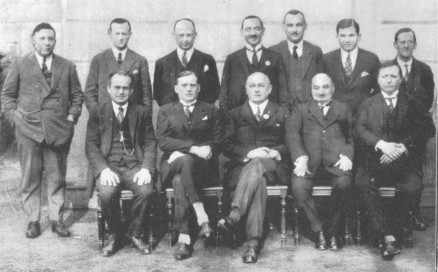
Standing, from left to right: A.
Rubinstein, F. Sämisch, S. Tartakower, C. Jobst, M. Blümich,
L. Steiner, F. Yates
Seated: A. Nimzowitsch, A. Alekhine, O. Krüger, W. von
Holzhausen, P. Johner
Below is a photograph of Julio Bolbochán, from page 55 of the February 1956 issue of the Argentinian magazine Ajedrez Revista Mensual:
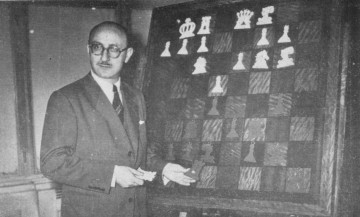
Peter Anderberg (Harmstorf, Germany) has now found that the
spurious mate under discussion appeared in print shortly after
the Fischer v Bolbochán game was played. Our correspondent
quotes Ludwig Rellstab in Schach-Echo, 23 April 1962,
page 121:
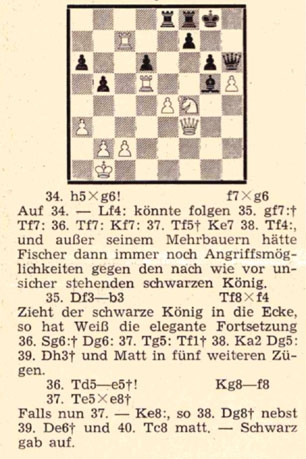
The relevant note is at move 35: ‘Zieht der schwarze König in die Ecke, so hat Weiß die elegante Fortsetzung 36 Sg6:+ Dg6: 37 Tg5: Tf1+ 38 Ka2 Dg5: 39 Dh3+ und Matt in fünf weiteren Zügen.’ (English translation: ‘If the black king goes into the corner White has the elegant continuation 36 Nxg6+ Qxg6 37 Rxg5 Rf1+ 38 Ka2 Qxg5 39 Qh3+ and mate in five more moves.’)
As the Fischer v Bolbochán game was played in round 21 of the
Stockholm tournament, i.e. on 3 March 1962, we now learn that
the illegal line was seen the following month already. Will this
topic produce any further surprises?
Readers are invited to identify these ‘Cosmopolitan chessmen’ featured in the Illustrated Sporting and Dramatic News of 11 November 1876, a picture sent to us by Eric Fisher (Hull, England):
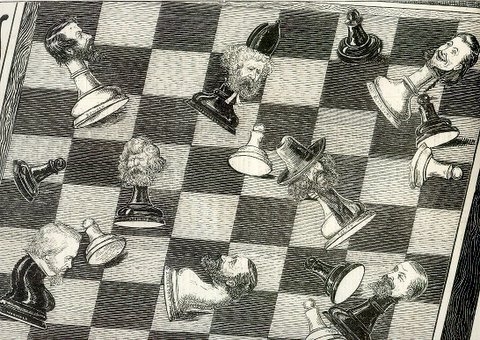
C.N. 3866 asked which world champion stated:
‘As has been known for a long time, I am a very solitary person and have very few relations with the outside world.’
The answer is Botvinnik. The remark appeared in an article entitled ‘Chess Kaleidoscope’ by Eliot Hearst on page 135 of the June 1962 Chess Life, the subtitle being ‘Botvinnik Meets the Press (Excerpts from an interview for the Latvian magazine Šahs)’.
From page 356 of Chess Review, December 1956, under the title ‘But is it Unique?’:
‘The British Manchester Guardian reported the Third Rosenwald Tournament as follows:
“Reshevsky won the New York Tournament with 9 out of 11, followed by Bisguier 7. An incident probably unique in tournament play took place in the game between Mednis and Hearst, who were both judged to have lost on the time-limit.”’
Eliot Hearst (Tucson, AZ, USA) has related to us what happened:
‘The Mednis game may be unique as to why we both received a “0”. Hans Kmoch, the tournament director, announced before the event began that anyone who did not keep an accurate, up-to-date score in time-pressure would be forfeited. The players did not like this rule very much, but I recall no serious objection. Edmar Mednis and I fell into tremendous time-pressure and we both failed to record the last few moves before the time-control. So Kmoch forfeited both of us. At the time we thought it unfair, although now I can be more understanding; perhaps Kmoch was right, as the rule had been announced beforehand. Neither of us overstepped the time-limit. Since I had a lost position I argued strongly that I could resign the game (Edmar was a good friend, and why should both of us suffer?), but Kmoch would not allow that.’
The above-mentioned Hearst v Mednis game occurred in the tournament where Fischer played what was termed the ‘Game of the Century’. Some writers – see, for instance, page 262 of Grandmasters of Chess by Harold C. Schonberg (Philadelphia and New York, 1973) – have omitted to specify that the remark was made in the context of games by prodigies. We reproduce below the relevant part of Hans Kmoch’s article (far from accurate as regards historical details) on page 374 of Chess Review, December 1956:
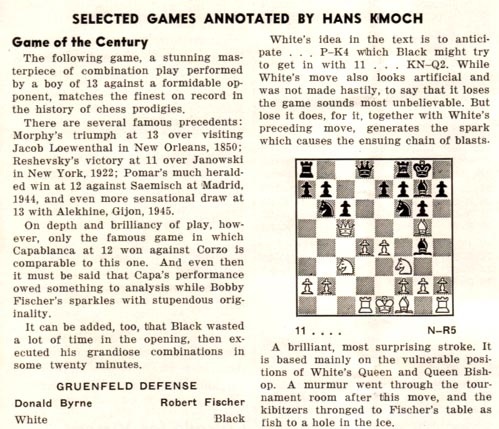
A jotting in passing: the illustration below has nothing to do with the front cover of the 1995 edition of My 60 Memorable Games but is merely the heading to an article on Fischer by Noel Busch in Reader’s Digest, March 1972 (pages 83-86):

Jonathan Berry (Nanaimo, BC, Canada) notes that a prodigy not yet mentioned in our recent series is Daniel Abraham (Abe) Yanofsky (see page 245 of A Chess Omnibus). Here we give a brief item from page 47 of CHESS, 14 October 1938:
‘Master Abie [sic] Yanofsky
Canada’s boy wonder has a dual right to the above title now. Only 14 years old, he had to beg time off from school to compete in the Canadian national championship, yet beat three former Canadian champions, Blumin, Belson and Martin, in consecutive games. Against weaker players he proved inconsistent, Maurice Fox, of Montreal, winning the title.
The Daily Mirror thought he was a girl, “Just a little schoolgirl” ran their headline. “She finished equal fourth ...” their report.’
Below is an inscription by Yanofsky in our copy of his fine autobiographical work Chess the Hard Way! (London, 1953):
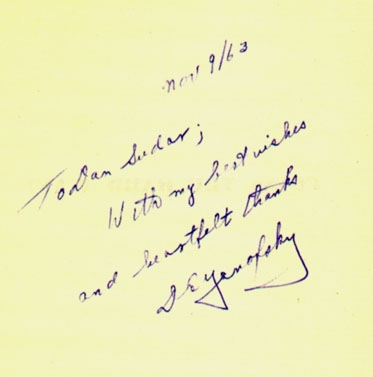
It has been noticeable in recent years that the intensity of hankering for an/any award is often inversely proportional to the merit of the hankerer and to the prestige, if any, of the award hankered for. The spectacle is an embarrassment, of course, but it is difficult too to take seriously those ‘hall of fame’ schemes so favoured in the United States. There even exists, we jest not, a ‘World Chess Hall of Fame’ whose ‘inductees’ as ‘charter members’ include ‘Robert James (Bobbie) [sic] Fischer’. He is in the 2001 crop, which also cheapens the memory of Morphy, Steinitz, Lasker and Capablanca (although Alekhine escapes) by appointing them World Chess Hall of Fame inductee charter members, or possibly World Chess Hall of Fame charter member inductees.
Turning to an older initiative on a rather more elevated plane, we wonder what became of the FIDE project reported on page 648 of the December 1980 BCM:
‘The International Chess Federation has decided to award gold medals as follows: “Alekhine Medal” for the best attack; “Capablanca Medal” for the best endgame; “Lasker Medal” for the best defence, and “Steinitz Medal” for the best strategical plan. A commission, composed of Dr M. Euwe (Chairman), GM G. Barzca, GM A. Kotov, GM A. Matanović, GM M. Najdorf and GM L. Schmid, will select the players that will be awarded the prizes annually at the FIDE Congresses. For the first award, in 1981, games played in 1980 must be sent to the FIDE Secretariat by 1 March 1981, with short commentaries ...’
On pages 83-86 of How to Cheat at Chess (London, 1976) William R. Hartston offered advice on the art of annotating:
‘... For the benefit of the potential writer who may find himself forced to provide notes to some game he does not comprehend, we end this short course with a typical annotated game. All the notes (with very slight modifications where necessary) have actually appeared in chess journals during the past few years; most of them will probably appear again in the course of the next few years for they all bear the trade mark of an expert notewriter, in that they convey no precise information about the position and have that all-purpose look about them which is so useful when you feel like writing a note, but do not know what to say. We hope the reader will himself make full use of these notes when annotating games himself; in view of the forthcoming world shortage of original notes, he should find all he needs in this short game.’
Hartston then gave the 1 d4 e5 2 Qd2 version of the composed stalemate game (C.N. 3679), annotated with such observations as: ‘When Black can play this move safely he invariably solves his opening problems’, ‘Other lines cause the defence little difficulty’, ‘Those who are familiar with the teachings of Nimzowitsch will recognize his influence on the central play in this game’ and ‘This position had undoubtedly been foreseen by both players’.
But now Alan O’Brien (Mitcham, England) points out to us that most, if not all, of the 24 notes used by Hartston were taken from a single writer, i.e. from the two ‘Play the Experts’ Way’ articles on pages 75-77 of the March 1970 BCM and pages 100-103 of the April 1970 issue (the games Tukmakov v Tal and Jacobsen v Ljubojević). The articles were by W. Ritson Morry.
C.N. 3270 gave the conclusion of a forgotten Alekhine game played in Rio de Janeiro on 31 May 1939 against J.V. Monteiro, our source being pages 78-79 of Monteiro’s book Dicionário Brasiliense do Jogador de Xadrez (Rio de Janeiro, 1956). We requested, without success, ‘biographical information regarding Joaquim Valadão Monteiro, whose other chess books included Dicionário Brasiliense de Têrmos Enxadrísticos (Rio de Janeiro, 1953)’.
Now, though, we have a doubt about the spelling of his name: were we correct to put ‘Valadão’, or should it be ‘Valladão’? In the Dicionário Brasiliense do Jogador de Xadrez the former version appeared in print throughout, including the front cover (see below) and the title page, yet twice his name was handwritten ‘Valladão’ (i.e. under his portrait and at the end of the Preface):
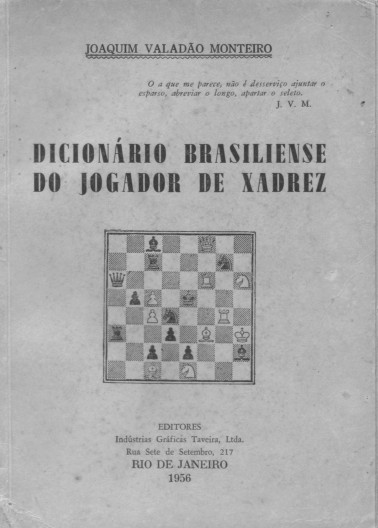
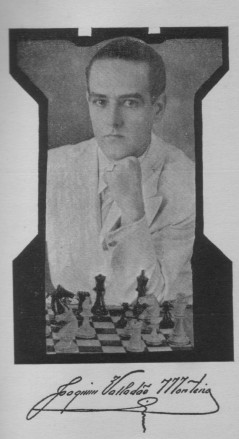
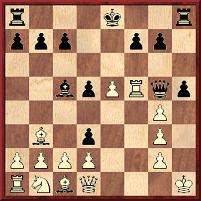
This position (after 13...h7-h5) occurred in a game lost by Anderssen (White), but, as noted in our previous items, sources vary as to whether Black was Max Lange or Jean Dufresne, whether the venue was Breslau or Berlin and whether the date was 1859 or circa 1851.
Toni Preziuso (Chur, Switzerland) reports that Emanuel Lasker’s chess column in the Vossische Zeitung of 11 August 1918 had the same version as in Bachmann’s Schachjahrbuch 1917/18 (which was published in 1919), and that it was presented as Anderssen v Dufresne but without any venue or date. The score ended ‘13...h5 and wins’.
Mr Preziuso adds that the source indicated by Lasker was a recent column by Nimzowitsch in the Baltische Zeitung, and that Nimzowitsch had obtained the game from Max Harmonist:
‘Wir entnehmen die folgende Partie der Baltischen Zeitung. Der Leiter von deren Schachspalte, Meister Niemzowitsch, hatte sie vor Jahren von Harmonist erhalten und übergab sie kürzlich der Öffentlichkeit.’
Our correspondent comments:
‘That does not clear up the questions about this mysterious Anderssen game but it does, I think, show the provenance of the game-score in Bachmann’s Schachjahrbuch.’
We add that Harmonist died in 1907. The photograph below was published on page 356 of Kagans Neueste Schachnachrichten, 1926:
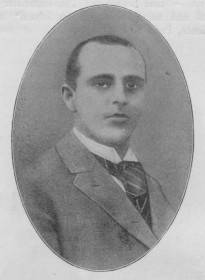
Max Harmonist
From William Hartston (Cambridge, England):
‘All I can say to your correspondent is: well-spotted. That chapter of How to Cheat at Chess was based on an article I’d written earlier for Dragon (the magazine of the Cambridge University Chess Club) called “Write Notes The Expert’s Way” as a parody of Ritson Morry’s banalities in his BCM column. I’m not sure how many changes I made for the book – unlike some writers, I’m not a great fan of cut-and-pasting – but the basic material for that bit of the book certainly came from the Dragon article.’
Michael Syngros (Amarousion, Greece) has submitted documentation (including the front cover of a later book, Glossário Caissiano (Rio de Janeiro, 1961), as well as personal stationery) which seems to present an overwhelming case for the spelling ‘Valladão’:


We now see that the double-L spelling was also used by L’Echiquier in 1932 when publishing problems by him.
C.N. 3885 gave further information on the Anderssen loss for which ‘sources vary as to whether Black was Max Lange or Jean Dufresne, whether the venue was Breslau or Berlin and whether the date was 1859 or circa 1851’.
Now Peter Anderberg (Harmstorf, Germany) quotes from Nimzowitsch’s column in the Baltische Zeitung, 5 June 1918, page 5:
‘Eine Glanzpartie.
Folgende wenig bekannte, überaus glänzend durchgeführte Partie soll – so lautet wenigstens die mündliche Überlieferung – zwischen den älteren Meistern Anderssen und Dufresne gespielt worden sein; da indes geschichtliche Daten fehlen, so geben wir die Namen der Spieler unter Vorbehalt wieder. Die Partie selbst ist dem jetzigen Redakteur dieser Rubrik und Schreiber dieser Zeilen vor vielen Jahren (1902) von dem inzwischen verstorbenen Meister Harmonist – Berlin freundlichst mitgeteilt worden. Wir glauben nicht, daß sie bereits veröffentlicht sei.’
Then followed the game-score of ‘Anderssen v Dufresne’, with the final moves given as 14 gxh5 Qxf5 15 g4 Qf2 16 g3 Qxg3 17 Qf1 Qxg4 0-1.
It should be noted that Nimzowitsch exercised care, stating that it was merely an ‘oral tradition’ that the game had been played between Anderssen and Dufresne. He also specified that the score, which he believed to be previously unpublished, had been shown to him by Harmonist in 1902.
However, our correspondent mentions that Max Lange himself had published this game as ‘Anderssen v Lange, Breslau, 1859’ on page 217 of his book Der Meister im Schachspiel (Weimar, 1881), with the finish 21 Bh3 Qxh3 mate, as was pointed out by Hans Ellinger of Tübingen, Germany on page 57 of issue 13 of Kaissiber.
As regards the twentieth-century publication of the game, Mr Anderberg suggests the following as the likely historical sequence:
‘1. In old age Dufresne showed Harmonist this game, around 1890 – “an Anderssen loss”.
2. In 1902 Harmonist showed the game to Nimzowitsch (a student in Berlin) – “an Anderssen loss, handed down by Dufresne”.
3. Nimzowitsch published the game with the proviso that the players’ names were dubious.
4. Lasker removed all trace of doubt about the game’s authenticity.
5. Finally, Bachmann made up “Berlin, 1851?”.’
Toni Preziuso (Chur, Switzerland) also draws attention to Max Lange’s book Der Meister im Schachspiel and provides the relevant text from page 217:
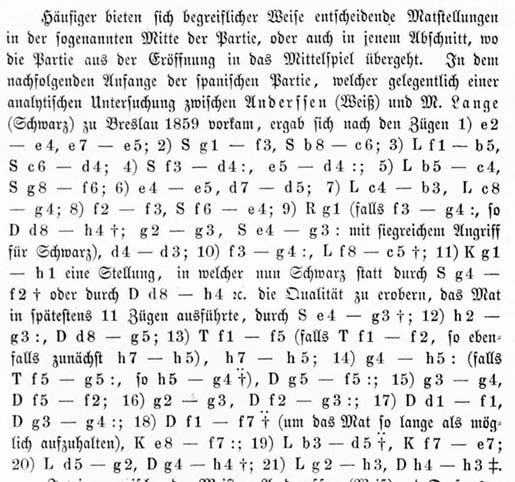
Lange wrote, in particular:
‘In dem nachfolgenden Anfange der spanischen Partie, welcher gelegentlich einer analytischen Untersuchung zwischen Anderssen (Weiss) und M. Lange (Schwarz) zu Breslau 1859 vorkam, ergab sich nach den Zügen ...’
Mr Preziuso comments:
‘So it is clear that it was an “analytical exploration” between Anderssen and Lange in Breslau 1859.’
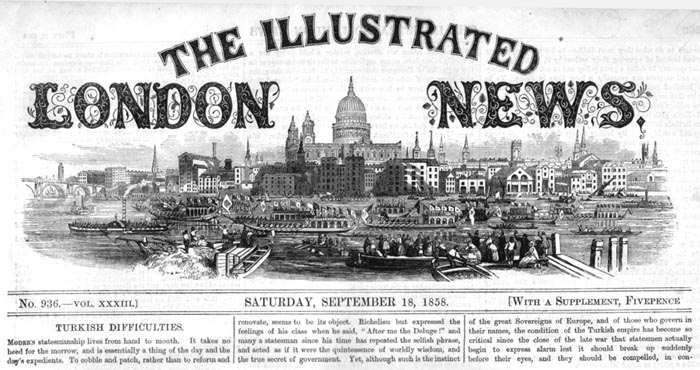
As an example of the extent of the press coverage accorded to Paul Morphy in his heyday we reproduce from our collection the complete page 255 of the Illustrated London News of 18 September 1858:

For a larger version, click here.
Regarding the picture of Morphy the magazine stated:
‘The Engraving above represents our young hero as he appeared in the rooms of Queen’s College, Birmingham on the 27th ult., when, before a numerous assemblage, he contested eight games, without the aid of chess board or men, against eight members of the British Chess Association ...’
The same issue (page 272) had Staunton’s chess column, with further Morphy material:

A readable version is provided here.
C.N. 3590 gave Samuel Loyd’s ‘photographic chessboard’ (dated 1868). It included a small photograph of Morphy which we do not recall seeing elsewhere, and below is our best effort to present it in enlarged form:
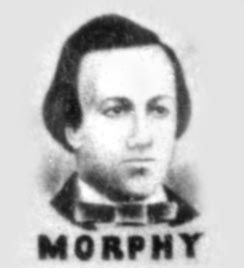
It would seem a relatively late picture and, for purposes of comparison, below are two photographs from page 332 of David Lawson’s book Paul Morphy The Pride and Sorrow of Chess (New York, 1976):
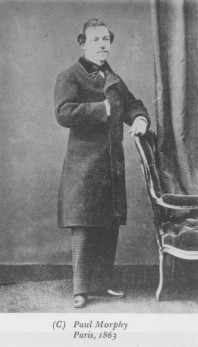
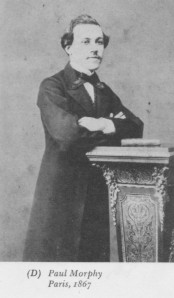
It may be wondered whether both dates (1863 and 1867) in Lawson’s captions are correct, since the photographs appear to have been taken around the same time.
On page 53 of Chessworld January-February 1964 Lawson published what he described as ‘the last photo of Morphy ever taken’, a shot which, on page 333 of his book, was labelled ‘New Orleans, 1870’:
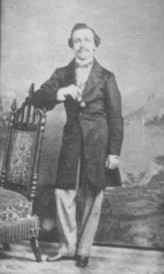
From John Hilbert (Amherst, NY, USA):
‘My account of Major William C. Wilson’s death on pages 1-18 of Essays in American Chess History (Yorklyn, 2002) ends in August 1897. But I’ve just learned the circus kept going for some time.
On the night of 4 October 1897 a man calling himself William Harris turned himself in to Philadelphia police, claiming he was one of three men who had murdered Major William C. Wilson, “the aged librarian who was killed in his book store”. Harris said he accompanied two men to Wilson’s store with the object of robbing him, then beat him to death. Source: New York Times, 6 October 1897 (attributing the information to Philadelphia, 5 October).
Another account shortly thereafter indicated Harris claimed that they had beaten Wilson to death with a hatchet, and that Wilson’s missing watch “would be found in a potato patch in New Jersey, two miles below Gloucester”. Detectives couldn’t find the watch, “and it is said that other parts of Harris’ so-called confession lack corroboration”. The paragraph appeared under the title “Probably a Fake Confession” in The News (Frederick, MD), 6 October 1897 (attributing the information to Philadelphia the same day).
Philadelphia’s District Attorney Graham and Director of Public Safety Riter were mulling over Harris’ confession, and “the impression is that the prisoner is not of sound mind and is not guilty. It has been learned that his right name is John Tittemary”. (New York Times, 7 October 1897.)
So passes Harris/Tittemary from at least the annals of this crime. The next strand appeared in February 1898, when Philadelphia police let it be known they were looking for “Big Bill” Mason, “a well-known western crook”, in connection with the murder. One source noted that “Mason is said to have Major Wilson’s missing watch in his possession”. (Middletown Daily Argus (Middletown, NY), 6 February 1898.) Just who said Big Bill had the watch, or how it was known, remained unsaid.
William Mason, alias “Big Bill”, now described as “one of the most desperate criminals in the country”, was arrested in July 1898, along with three other criminals: George, alias “Red” Spencer; Thomas Reilly, and Jim Coffey. (The North Adams Transcript (North Adams, MA), 13 July 1898.)
New York granted extradition of Big Bill Mason to Pennsylvania within four days of his arrest. Mason had been captured in New York City the previous Monday night, 11 July 1898. (Middletown Daily Argus (Middletown, NY), 15 July 1898.)
On 7 September 1898 Big Bill’s cohort “Red” Spencer was sentenced to nine months in the penitentiary for carrying burglars’ tools, while Thomas Reilly was given a year. The short paragraph noted Big Bill Mason had been sent to Philadelphia “on a charge of murder”, but nothing more was reported. (New York Times, 8 September 1898.) Nor was there any suggestion Big Bill had been found carrying Wilson’s watch, the serial number of which was in the possession of the police.
And there the trail goes cold once more. I could find nothing else about Big Bill Mason or about Wilson’s Mysterious Murder, as various periodicals called the death of the small chessplayer who had in his younger days escaped Confederate prison, but who could not escape death by bludgeoning in his own shop.’
Calle Erlandsson (Lund, Sweden) writes:
‘Wojciech Bartelski, the editor of OlimpBase, has noticed that ChessBase has the identical game-score for the encounters between Lilienthal and Bolbochán at the sixth Olympiad (Warsaw, 1935) and at the seventh (Stockholm, 1937):
1 d4 Nf6 2 c4 e6 3 Nc3 d5 4 Bg5 Nbd7 5 Nf3 c6 6 e4 dxe4 7 Nxe4 Be7 8 Nc3 c5 9 Qc2 cxd4 10 Nxd4 h6 11 Bh4 O-O 12 Be2 a6 13 O-O Qb6 14 Rad1 Re8 15 Bg3 Nf8 16 Na4 Qa5 17 c5 Nd5
18 Nb6 Nxb6 19 Nb3 Qa4 20 cxb6 Bf6 21 Bf3 e5 22 Rfe1 Qb5 23 Qc5 Re6 24 Qxb5 axb5 25 Nc5 Rxb6 26 Bxe5 Bf5 27 Bc7 Rc6 28 Bxc6 bxc6 29 Be5 Rxa2 30 Bxf6 gxf6 31 Rd2 Ng6 32 h3 h5 33 Ne4 Bxe4 34 Rxe4 Kg7 35 Re8 c5 36 Rb8 b4 37 Rb5 Ra1+ 38 Kh2 Rc1 39 Rd5 Rc2 40 Rdxc5 Rxb2 41 Rxh5 Rxf2 42 Rxb4 f5 43 Kg1 Resigns.
Furthermore, this same game was given on pages 186-189 of The Lost Olympiad Stockholm 1937 by W.H. Cozens (St Leonards on Sea, 1985) and on pages 141-142 of VI Wszechświatowa Olimpiada Szachowa Warszawa 1935 by M. Litmanowicz (Warsaw, 1995). Although Cozens included detailed annotations, the game was indeed played in Warsaw.
The Stockholm game between the two players began 1 d4 Nf6 2 c4 e6 3 Nf3 d5 4 Nc3 Nbd7 5 e3 Be7 6 Bd3 c5 7 O-O O-O. The complete game-score and the 683 others from the Stockholm Olympiad are scheduled to be published in an extensive book by Peter Holmgren and me in 2007.’
Below are photographs of the Argentinian team at the 1937 Olympiad in Stockholm, from page 273 of El Ajedrez Americano, September 1937. The Bolbochán at both Olympiads was Jacobo, the brother of Julio.
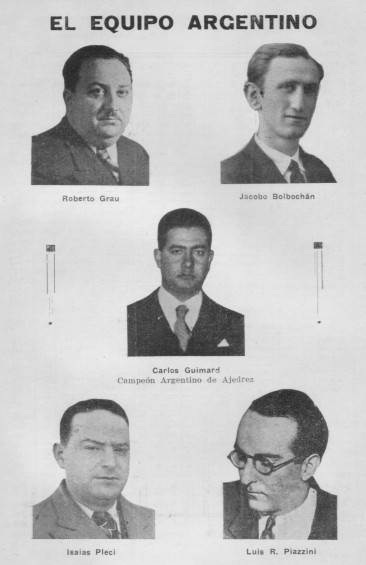
A contribution from Rick Kennedy (Columbus, OH, USA):
‘Sergei Salov, a Russian chessplayer and past Deaf World Chess Champion (ICSC GM; FIDE IM) wrote an article (accompanied by 30 games) on Verlinsky (in English, Russian and German) for the first – and, as far as I know, only – issue of Chessarchive (1/1999), a publication focused on deaf chessplayers. Excerpts follow, firstly on Verlinsky’s introduction to chess and early play and secondly on his gain and loss of the grandmaster title:
Verlinsky became acquainted with chess at 13 years of age and was soon one of the strongest chess players in Odessa ... Verlinsky obtained his initial tournament experience in St Petersburg (1909) where he took part in the amateur tournament of the International Chess Congress in memory of M.I. Chigorin. This was held in parallel to the main tournament, the ‘Tournament of the Maestros’ ... The young man from Odessa, Verlinsky, eventually shared the tenth place with P. Romanovsky, whom he was able to beat in direct confrontation ...”
“In the twenties Verlinsky’s talent reached its summit. In 1924, he was awarded the title of Grand Master for his success in the third championship in the USSR ... In 1928, Boris Verlinsky gained first place in the city tournament in Moscow and one year later he achieved the greatest success of his life. He became the Russian champion in Odessa. A short time later at a session of the chess departments of the republic the rules were changed and he was awarded the lifelong title of Grand Master. Boris M. Verlinsky thus became the first Soviet Grand Master. Sixty years after this event the chess historian I. Romanov wrote, ‘unfortunately he was not able to hold this title for long – only two years. The seventh chess congress of the union removed this title when discussing the question of qualification. From the tribune of the congress they proclaimed that: “The terms master and championship should no longer be used as they work for the expression of an individual approach to chess.” Time has corrected this left wing swing but first poor Verlinsky has proved to be the victim.’ (Bulletin of the Central Chess Club of the USSR, No. 30, 1988.) ...”’
This chart illustrated an article by a (fairly well-known) chessplayer. Who?

In C.N. 3854 Neil Brennen (Spring City, PA, USA) supplied from the Philadelphia Times of 20 November 1898 a loss by Ching-Chang, an automaton which the columnist at one point called ‘Mr P-’. The question raised was whether Pillsbury was meant. Now Mr Brennen quotes a passage from the same newspaper three weeks later (11 December 1898):
‘Miss Maynell DeVaney asks who Mr P- is who manipulated Ching-Chang against Mr Hall. Well, it’s something of a secret, at least as far as print is concerned, but when we tell her it is a very celebrated player she will be able to guess the name.’
Mr Brennen also provides some excerpts from Reichhelm’s column a little earlier in the year. On 11 September 1898 he wrote, ‘the famous chess automaton is now in our midst’, and a fortnight later he referred to the machine as ‘Ultimatum’ when presenting its encounter with Charles Newman:
Ultimatum – Charles John Newman
Philadelphia, 1898
French Defence
(Notes – abridged – by G. Reichhelm)
‘What chessplayer has not heard of the famous Ultimatum? It is true, this is not exactly its name, but it is what Judge Wolff calls it, and whatever he says goes. The Ultimatum had been pursuing an uncheckered career of victory, when in an evil moment for itself Charles John Newman, of the Franklin Chess Club, appeared on the scene, and at once the machinery of the enchanted figure began to creak …’
1 e4 e6 2 d4 d5 3 e5 f6 4 exf6 Nxf6 5 Nf3 c5 6 Bb5+ Nc6 7 Ne5 Qb6 8 Bxc6+ bxc6 9 dxc5 Bxc5 10 Nd3 O-O 11 Nxc5 Qxc5 12 O-O e5 13 Qe2 e4 14 c3 Ng4 15 Be3 Qd6 16 f4 exf3 17 gxf3 Ba6
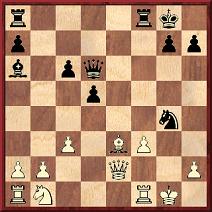
‘At this point there was a pause and the machine which descended from the conqueror of Frederick the Great and Napoleon found that it lacked the necessary wheel to make an answer. Seeing this, Mr Newman, with the characteristic courtesy of a great master, offered a draw. And thus endeth the lesson, of which the moral has been mislaid.’ Drawn.
Quite apart from Ching-Chang and Ultimatum, it may be wondered how Ajeeb fits into the story. We quote from page 212 of Chess: Man vs Machine by Bradley Ewart (London, 1980):
‘... Pillsbury planned to take Ajeeb “out west” and it is known that he exhibited the automaton for several weeks in 1898 at the Dime Museum at Ninth and Arch Streets in Philadelphia. While there, Charles J. Newman, an international cable chessplayer, went one day to play the automaton. “I should have beaten him”, reported Newman, “if after lifting a rook he had not put it back and played another piece. Can this automaton take moves back?”, I asked indignantly. “Yes”, said the lady attendant, “he can”. And worse luck he did.’
To add cultural depth to their output, many chess authors quote the masters of the past, i.e. they say (without specifying a source) what another writer said (without specifying a source) the master said.
From page 19 of Catastrophe in the Opening by James Plaskett (London, 2005):
‘Alexander Alekhine once said that to wrest a point from him an opponent would have to beat him three times: once in the opening, once in the middlegame and once in the ending.’
Did Alekhine ‘once’ make such a claim? As noted in C.N. 2104 (see page 230 of Kings, Commoners and Knaves) Larry Evans’ introduction to the eighth game in Fischer’s My 60 Memorable Games began:
‘Alekhine said, in his prime, that to wrest a point from him it was necessary to win the same game three times: once at the beginning, once in the middle, once at the end.’
However, the only such remark that we have managed to find was by Tartakower (CHESS, 14 March 1939, page 241), in a discussion of his victory over Alekhine at the Folkestone Olympiad in 1933:
‘As usual against “Alexander the Great”, one had to beat him three times over to score a single point against him.’
Incidentally, the phrase ‘Alekhine said, in his prime, that ...’ defeated the translators of at least two editions of Fischer’s book:
The photograph below (from his prime, not his youth) appeared on page 316 of the November 1933 Tijdschrift van den Nederlandschen Schaakbond:

Alexander Alekhine
A great player of the olden days is the subject of a large new monograph, Vabanque Dawid Janowsky 1868-1927 by Daniel Ackermann. In the present brief notice, a few facts and figures are provided. It is a handsome 723-page hardback in German which includes a biographical narrative, 335 games (virtually all of them annotated), tournament tables and match charts, 12 pages of endnotes (the second of which errs by attributing to us a comment in C.N. 418 by W.H. Cozens), indexes and a nine-page bibliography.
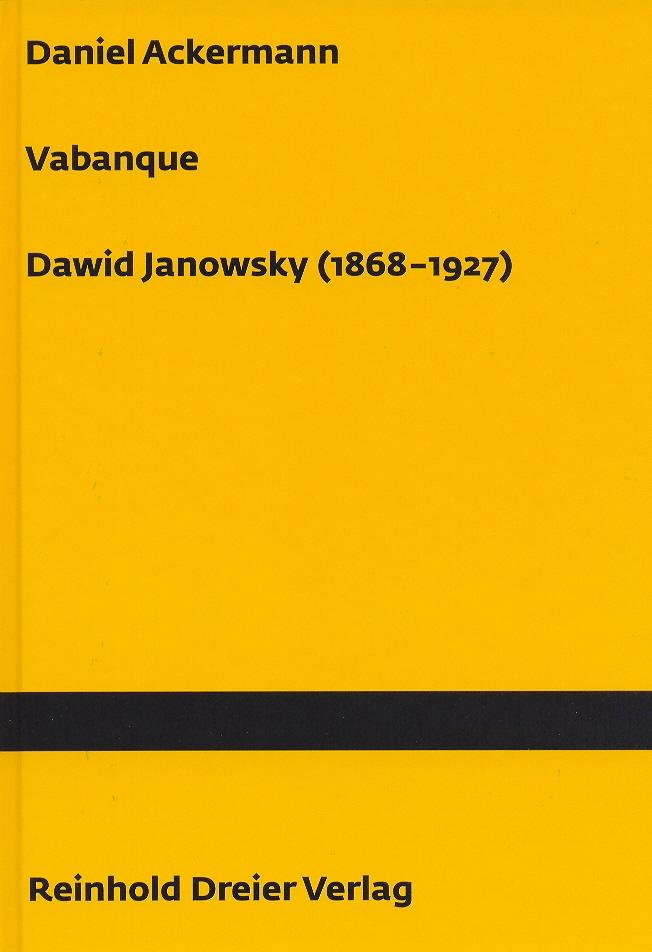
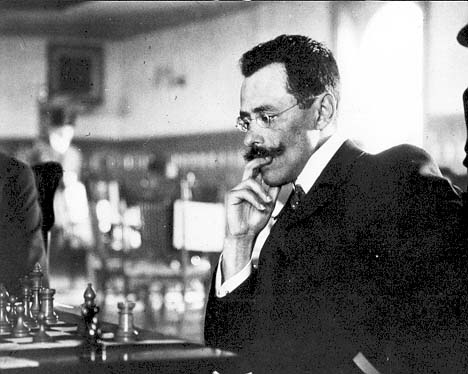
Christian Sánchez (Rosario, Argentina) is prompted by C.N. 3896 to point out the following observations by Euwe on page 15 of the January 1966 BCM:
‘In former times, once having lost the first phase of the game, the amateur made some more weak moves and then went down to defeat. That is no longer the case. In general, one mistake is not sufficient to lose a game of chess; it takes two mistakes to decide the issue. That is why the very strong players so seldom lose a game. Certainly they make mistakes from time to time, but they restrict them to one per game. And now it appears that the amateur also knows that he need not despair after his first error – provided, of course, that this error is not too serious. He can still fight, and his master opponent has to make things so complicated that the amateur falters a second time. Chess has become twice as difficult: to score one point, you have to win twice.’
Two of James J. Barrett’s notable contributions to C.N. from the 1980s have recently been reproduced here: the account of Alekhine’s alleged suicide attempt (C.N. 3842) and, a particularly satisfying scoop, the first of Two Edge Letters to Fiske. Dale Brandreth (Yorklyn, DE, USA) now informs us:
‘He died early this year, and an auction of his chess collection took place in Buffalo on 18 June. A true bibliophile, he started collecting chess items in the early 1930s and continued for his entire life, though he slowed down considerably after age 80. Chess books were his entire life outside of his job at Mohawk Power and Light, where he was a mid-level manager.’
Dr Brandreth adds that James J. Barrett wrote a few chess columns in the Buffalo area. Yet beyond that, we note, his name was seldom seen in chess literature, a rare appearance in a chess magazine being on page 1 of the March 1948 Chess Review: a letter of complaint about the magazine’s choice of front-cover photographs. He did, however, play a substantial role in Paul Morphy The Pride and Sorrow of Chess by David Lawson (New York, 1976), and in the Acknowledgments (page vii) Lawson wrote, ‘I wish particularly to express gratitude for the suggestions and generous help of James J. Barrett, with special reference to the selection, preparation, and proofreading of the games.’
Mr Barrett’s contributions to C.N. were of high quality and greatly appreciated. We miss his letters, packed as they were with erudition and common sense.
David Lovejoy (Mullumbimby, NSW, Australia) asks whether anything substantial has been written about the life of Savielly Tartakower, beyond his own two-volume collection of best games. We believe not. There is a small monograph on him, Ksawery Tartakower by Stefan Witkowski (Warsaw, 1994), but little else.
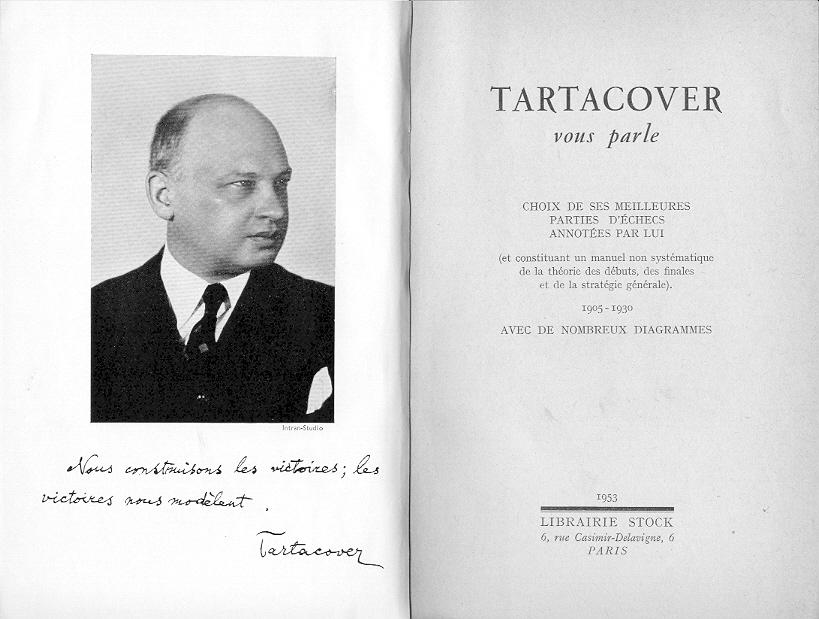

As regards Tartakower’s own extensive writings, some of his most interesting reminiscences appeared in a series of articles in Chess Review in the early 1950s. They included forgotten specimens of his play, and below is an excerpt from ‘End-game secrets’, on pages 328-329 of the November 1951 issue:
‘This position is from a skittles game played recently in Paris:
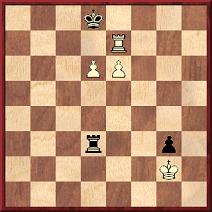
Fleck v Tartakower
Fleck has attacked furiously, but I have managed to reach a position in which, paradoxically enough, the win is impossible. There follows:
1 Rd7+ Ke8 2 Kh3 (White’s last hope is to arrive at a Zugzwang position in which he can win [Black’s] sole remaining – and very annoying – pawn.) 2...Re3! Drawn.
“How unlucky the amateurs are”, Monsieur Fleck complained after the game. “Even when they succeed in winning material against the master, their efforts are not crowned with ultimate success.”
“We are saved by routine”, was my reply.
This example (from a simultaneous exhibition in Barcelona, 1935) is a companion piece to the previous position. Black plays with amazing resourcefulness and self-control.
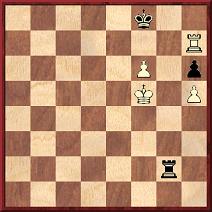
Tartakower v Amateur
1...Rf2+ (And not the plausible 1...Rg5+? 2 Ke6, after which White wins.) 2 Kg6 Rg2+ 3 Kxh6 (Now White is two pawns up, but his king is marooned.) 3...Rg1 4 Re7 (The continuation 4 Rg7 Rxg7 5 fxg7+ Kg8 6 Kg6 results in stalemate.) 4...Rf1 (But not 4...Kg8 5 Rg7+ Kh8 {if 5...Rxg7 6 fxg7 Kf7 7 Kh7 and White wins.} 6 Rg5 {not 6 Rxg1?? with stalemate, likewise after 6 f7?? Rg6+} 6...Rf1 7 Kg6 and White wins.) 5 Re6 Kf7. (The game was given up as a draw. Bravo, Amateur!)
These miraculous examples of last-minute salvation remind me of a miraculous ending, never previously published, that turned up in a skittles game played by Dr Alekhine and myself at the Palais Royal Chess Club in Paris on 23 July 1925.
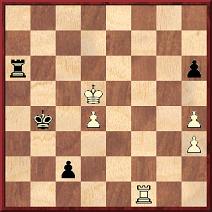
Tartakower v Alekhine
1...Ra5+ (Or 1...Kb3 2 Ke5 Kb2 3 d5 c1(Q) 4 Rxc1 Kxc1 5 d6 Kd2 6 d7 Ra8 7 Ke6 Ke2 8 Ke7 Kf3 9 d8(Q) Rxd8 10 Kxd8 Kg3 {or 10...h5 11 Ke7 Kg3 12 Kf6 Kxh4 13 Kg6 Drawn}11 h5! Kxh3 12 Ke7 Kg4 13 Kf6 Kxh5 14 Kf5 and White draws!) 2 Ke6! Rh5 3 d5 Rxh4 4 d6 Rxh3 5 d7 Rd3 6 Ke7
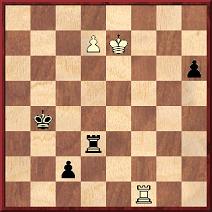
6...h5 (Or 6...Kb3 7 d8(Q) Rxd8 8 Kxd8 Kb2 9 Ke7 c1(Q) 10 Rxc1 Kxc1 11 Kf6 drawing.) 7 d8(Q) Rxd8 8 Kxd8 h4
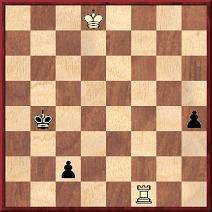
(Now the black pawn seems out of the white king’s reach; yet, by what seems nothing short of a miracle, the king can catch up to the pawn. A similar theme has been utilized by several endgame composers, among them Réti.) 9 Ke7 h3 10 Kf6 h2 (Again, if 10...Kb3 11 Kg5 Kb2 12 Kg4, drawing. Now that the rook pawn has advanced to its seventh rank, however, White is in a position to demonstrate a more piquant drawing method, in which his rook does most of the work. His king’s cooperation is no longer required.) 11 Ke7 (Also possible, of course, is 11 Kg5 Kc3 12 Kg4 Kb2 13 Kg3 c1(Q) 14 Rxc1 Kxc1 15 Kxh2, drawing. But the method selected by White is more amusing.) 11...Kc3 12 Rh1 Kd3 13 Kd8 Ke3 14 Ke7 Kf3 (Black threatens 15...Kg2.) 15 Rc1! Ke3 (Now he threatens 16...Kd2.) 16 Rh1! Drawn.’
We wonder whether any languages have a special (technical) term for the process, favoured for Russian books, whereby photographs are touched up, apparently by a gloved ten-year-old. Particularly ham-fisted examples will be welcomed, and below we repeat from C.N. 3757 (an item which itself discussed picture-tampering) a photograph of Capablanca and place alongside it the version which appeared as the frontispiece to I. Ilyin-Genevsky’s book Match Alekhin-Capablanca (Leningrad, 1927):
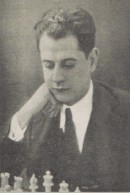
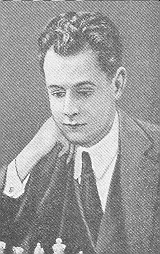
The Capablanca picture was also the basis for an Alekhine-Capablanca sketch found in various sources, such as the plate section of Complete Games of Alekhine, volume three by V. Fiala and J. Kalendovský (Olomouc, 1998):
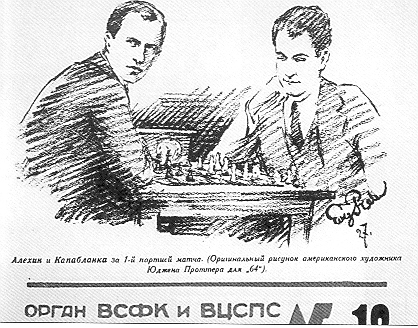
If a game begins 1 d4 d5 2 e3, a book or magazine is likely to have a heading (sometimes more prominent than the players’ names) ‘Queen’s Pawn Game’, ‘Queen’s Pawn Opening’ or ‘Queen’s Pawn’. These are innocuously interchangeable terms, but many openings offer the prospect of confusion and controversy. Not everybody is happy to call 1 e4 e6 2 d4 d5 3 Nc3 Bb4 the Winawer Variation or, even, to accept that 1 e4 Nf6 is Alekhine’s Defence. Nor is there any consensus on how far down the branches the tagging should continue. (Surely, though, not as far as 16...g3, which is the start of the ‘Utica Variation’ in the Rice Gambit Accepted.)
A relaxed attitude to openings nomenclature usually prevails, and it is difficult not to have mixed feelings about the entire subject. Consistency is desirable, but absolute uniformity is impossible. Order is wanted, but not regimentation. Historical priority is important, but not necessarily decisive. National considerations may play a role, but should not be excessive or jingoistic. Any player or analyst can risk ridicule by unilaterally christening an opening after himself or through recourse to soppy levity, but it is posterity that will decide, to the extent that it decides anything in chess. Opening codes may be seen as offering a safer, more coherent framework, but terms such as the ‘Dutch Defence’, ‘Falkbeer Counter Gambit’ and ‘Giuoco Piano’ are part of the culture and charm of chess.
About 75 years ago, a project was launched to standardize terminology. It resulted from an initiative within FIDE by Czechoslovakia to combat confusion by producing a properly thought-out list of openings. This grand design was recorded on page 12 of the minutes of FIDE’s Procès-verbal du VIe Congrès (Venice, 26-30 September 1929):
‘Les délégués de la Fédération tchécoslovaque soumettent le voeu que la FIDE s’emploie à dresser une liste raisonnée des débuts de partie, des variantes et des défenses, étant donné qu’il existe actuellement dans ce domaine une confusion malencontreuse.’
The delegates from Czechoslovakia agreed to draw up a draft by 1 April 1930. At that year’s FIDE Congress, in Hamburg, a committee was set up (involving the federations of Czechoslovakia, Germany, Holland, Poland and Sweden) to prepare by the following year a report on the draft (source: FIDE minutes of the 1930 Congress, page 18). In the summer of 1931 FIDE met in Prague and, as noted on page 7 of the minutes, the Secretary of the Czechoslovakian Federation, Josef Louma, reported that the draft had been revised by a large number of chess figures, including Tartakower and Grünfeld. Another year went by. Page 9 of the minutes of the Paris, 1932 Congress contained a brief note by the FIDE President, Alexander Rueb, that no further news was available on the openings project (which was described as ‘important mais difficile et considérable’. But then at Folkestone in 1933 the delegate from Czechoslovakia, Jan Bedrníček, presented a document by Louma, still described as a draft (‘avant-projet’). Rueb extended his warm congratulations, and the minutes (page 4) also reported that the work would be published, at FIDE’s expense, with profits going into the FIDE coffers. A further year passed, and it was not until the Zurich Congress in 1934 that, as noted on page 5 of the minutes, FIDE was able to announce with great pleasure that the book had just appeared:
‘Nous sommes infiniment heureux d’annoncer la terminaison du grand travail de classification des débuts de partie, dont s’était chargée la Fédération tchécoslovaque. Ce travail vient de paraître ...’

FIDE officials in Zurich, 1934.
Seated (left to right): M. Nicolet, A. Rueb and J. Bedrníček.
Standing: A. Fidi, I. Gudju, L. Miliani, C. Leu, C. de
Watteville and E.Voellmy
The product of half a decade’s exertion, or inertia, was a 54-page booklet Débuts du jeu d’échecs with the subtitle ‘Leur désignation uniforme’, published in Prague by officials of the Czechoslovakian Federation and revised by a Committee comprising Rueb, Przepiórka, Collijn, Grünfeld and Tartakower. Rueb’s introduction (page 6) described it as a first attempt at consistency (‘un premier effort vers la stabilisation de la nomenclature des débuts’) which did not claim to be complete, infallible or conclusive. Indeed, the term ‘avant-projet’ was still employed. A Preface by Louma stated that the ‘auteur du projet’ was Jaroslav Ferra.
By way of example, below are some of the fruits of the quinquennium:
It was a strange booklet and prompted some no less strange comments on page 377 of the September 1934 BCM:
‘1 Kt-QB3 is called “Partie Kotrč”. J.H. White was the first to analyse this opening to any extent, and in our opinion his name should be associated with it. Possibly Kotrč means White, but we have no knowledge of Czechoslovakian. We are not, of course, aware on what system the committee worked, nor the reason for some of their decisions. For instance, 1 P-K4 P-K4 2 Kt-KB3 P-KB4 is to be known as “Gambit letton”. 1 P-K4 P-K4 2 P-KB4 PxP 3 B-B4 P-KB4 is called “Gambit Gianutio”, but we hope that chess editors in general will accept the conclusions of the FIDE committee, as it leads to confusion where the openings are called by different names in different countries.’
The book’s impact was negligible, and it was no money-spinner. As recorded in the accounts (drawn up in Swiss francs) on page 6 of the minutes of the 1935 Congress in Warsaw, FIDE’s overall profits in 1934-35 included, from Débuts du jeu d’échecs, one franc 40 centimes. A single copy had been sold.

The above chart from C.N. 3894 is of Mercury, and the chessplayer who drew it was E.M. Antoniadi (1870-1944). In 1907 he came joint first with Marshall in a tournament in Paris, ahead of Tartakower, although he lost to Marshall in the play-off.
We took the chart from an article by Antoniadi entitled ‘The Markings and Rotation of Mercury’ on pages 99-105 of the Annual Report of the Board of Regents of the Smithsonian Institution, 1934. By the 1930s, he was concentrating on astronomy, and his name had by then disappeared from chess periodicals; indeed, on page 34 of his 1932 book Morphy Gleanings P.W. Sergeant pronounced him dead. Another item by Antoniadi open before us now is ‘The Minor Details of the Planet Mars’ on pages 802-803 of Nature, 3 June 1933. His book The Planet Mercury is readily available, translated from the French by Patrick Moore and published by Keith Reid Ltd., Shaldon in 1974. On page 7 Moore wrote:
‘... Antoniadi’s work, as presented in this book, is of the highest interest – both scientific and historical. The names given by him to Mercurian features are still in use, and will probably remain so; it was he who brought observing methods in planetary astronomy down to a fine art, and it is sad that he did not live to see the results of rocket probes sent out to the planet to which he devoted so much attention.’
The Mercury chart was on the front cover:
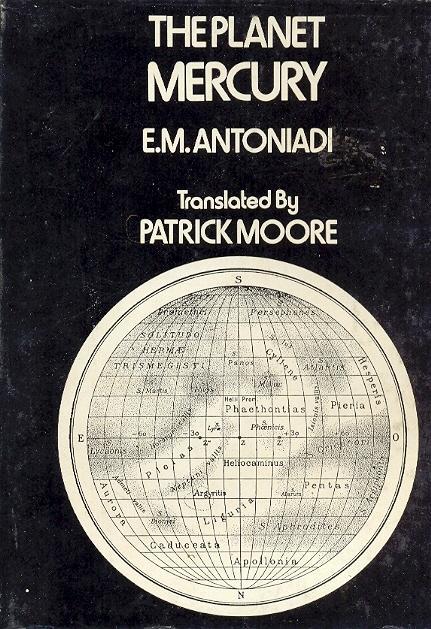
As noted in C.N.s 2799 and 2803, Richard McKim has written the only biographical account: ‘The Life and Times of E.M. Antoniadi’ in the Journal of the British Astronomical Association, volume 103, No. 4, pages 164-170 (1993) and volume 103, No. 5, pages 219-227 (1993). Below are two photographs of Antoniadi which illustrated Dr McKim’s two-part article and are reproduced in C.N. with the permission of the Journal of the British Astronomical Association:
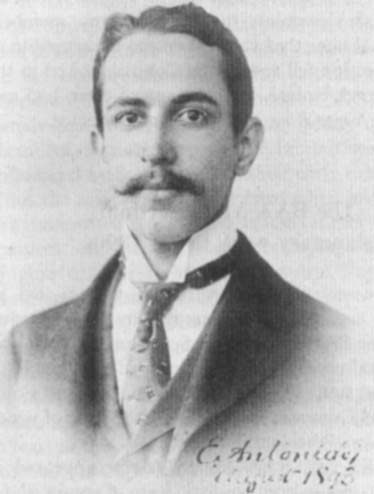
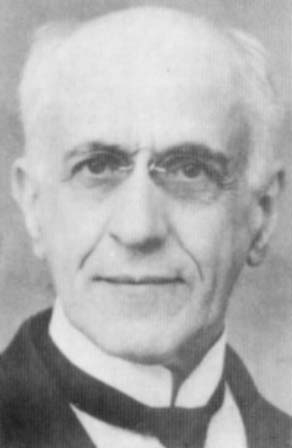
Claes Løfgren (Randers, Denmark) writes:
‘An addition worth mentioning to the sparse Tartakower literature is Schack-parad 2: Stormästaren Tartakower (Stockholm, 1987) by Erik Lundin. This fine book is based on autobiographical articles by Tartakower published in Tidskrift för Schack between 1947 and 1955, bound together with comments by Lundin and others. It features many wonderful games, anecdotes and reminiscences about tournaments and fellow masters throughout his career of almost 50 years.’
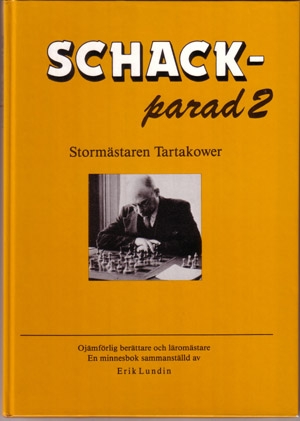
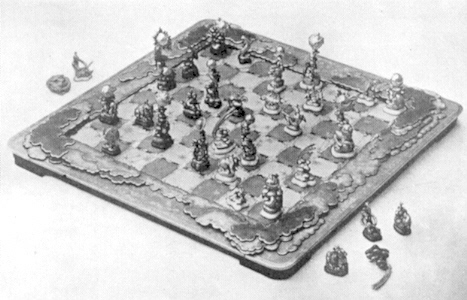
An explanatory note about this mystery chess set will appear in a future item.
Brian Karen (Levittown, NY, USA) asks for particulars about the
tour by Maróczy mentioned on page 103 of The Fireside Book
of Chess by I. Chernev and F. Reinfeld (New York, 1949):
‘Playing simultaneously in Europe from June 1927 to March 1928, Geza Maroczy compiled the almost incredible score, from a total of 943 games, of 825 wins, 113 draws and only 5 losses.’
Chernev gave the same brief item on page 56 of Curious Chess Facts (New York, 1937) and page 74 of Wonders and Curiosities of Chess (New York, 1974). The tour of Hungary by Maróczy, who was in his late fifties, was sparsely reported by magazines, but page 107 of the April 1928 Wiener Schachzeitung gave a complete chart of the 21 displays. In 17 of them Maróczy was undefeated, and the largest number of boards he faced was 81. That was in the first séance (Szeged, 18 June 1927), where his score was +69 –0 =12.
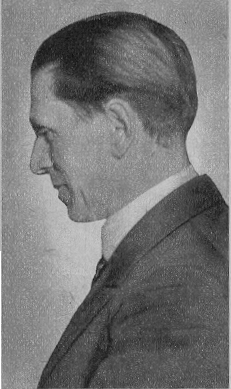
Géza Maróczy
As noted in C.N. 3375, page 33 of the February 1931 American Chess Bulletin referred to an exploit in simultaneous chess by István Abonyi (1886-1942). We now note that some details were given on page 45 of the February 1928 Wiener Schachzeitung and page 107 of the April 1928 issue. In Budapest on 21-22 January 1928 (from 19.00 to approximately 06.00, without a break) Abonyi faced 300 consulting opponents on 105 boards, scoring +79 –6 =20.
Marek Lada (Warsaw) sends us a photograph which he took in August 2005 of Adolf Anderssen’s grave at the Osobowicki Cemetery in Wrocław:
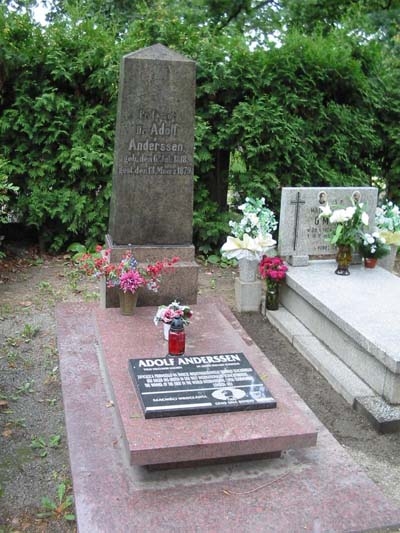
Chess Notes Archives:
| First column | << previous | Archives [13] | next >> | Current column |
Copyright 2005 Edward Winter. All rights reserved.